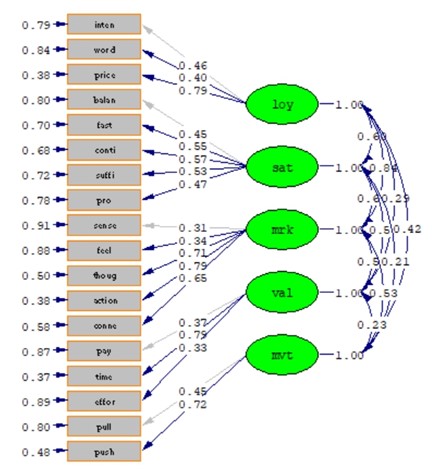The Confirmatory Factor Analysis of Spa Health Tourists’ Loyalty in Andaman Province
Main Article Content
Abstract
The purpose of this research is to examine the fit of the measurement model of factorial structure for spa health tourists’ loyalty. Data is collected from visitors of hotels, resorts and spas, which include foreigners from Russia, Australia, Germany, and the United Kingdom. Based on survey data gathered from 200 samples, the study was conducted. Foreign tourists, or European visitors who have used indoor spa services in hotels and resorts in rural districts, made up the sample group used in this study. For every kind of tourist, spa, hotel, and resort location, a random sample is provided. only four-level hotels and resorts were chosen. There are sixty-four places in all. A threshold of 50% of the total number of hotels and resorts was used to select the number of hotels for data collection, resulting in 32 locations. Proportional stratified random sampling was employed in each province to choose the hotels and resorts. There were nine hotels and resorts in the province of Krabi; two in the province of Phang Nga; and twenty-one in the province of Phuket. The researcher randomly drew the names of hotels and resorts in each province to meet the specified numbers. Every hotel and resort provided six to seven samples, and data collection was divided equally among all of the establishments. The data gathering only included foreign guests who had completed their spa treatments.
The results of the confirmatory factor analysis of loyalty among spa health tourists in the Andaman region provinces showed that the measurement model for loyalty variables of spa health tourists in the Andaman region provinces, including tourist satisfaction, perceived values, marketing experience, tourist incentives were consistent with empirical data. This consistency is evidenced by the following goodness-of-fit indices: the chi-square goodness-of-fit test, χ²/df = 2.33, p< .001, RMSEA = 0.07; NNFI = 0.93; CFI = 0.90; and SRMR = 0.06.
Article Details
References
กระทรวงการท่องเที่ยวและกีฬา กองเศรษฐกิจการท่องเที่ยวและกีฬา. (2563). รายงานภาวะเศรษฐกิจการท่องเที่ยว. http://www.mots.go.th.
กลุ่มงานบริหารยุทธศาสตร์กลุ่มจังหวัดภาคใต้ฝั่งอันดามัน. (2561). สถานการณ์การท่องเที่ยวกลุ่มจังหวัดภาคใต้ฝั่งอันดามัน. http://www.osmsouth-w.moi.go.th.
ศูนย์วิจัยเศรษฐกิจและธุรกิจ ธนาคารไทยพาณิชย์. (2562). ธุรกิจสปาไทยติด Top 5 ของเอเชีย. https://thestandard.co/thai-spa-top-5- asian-spa/
สุรสิทธิ์ อุดมธนวงศ์. (2562). อิทธิพลของแรงจูงใจที่ส่งผลต่อผลสัมฤทธิ์การท่องเที่ยวเชิงกีฬา จังหวัดภูเก็ต กรณีศึกษา อีเวนต์มาราธอน. วารสารสุทธิปริทัศน์, 33(106), 236-250.
สุวิมล ติรกานันท์. (2551). ระเบียบวิธีการวิจัยทางสังคมศาสตร์: แนวทางสู่การปฏิบัติ (พิมพ์ครั้งที่ 7). โรงพิมพ์แห่งจุฬาลงกรณ์มหาวิทยาลัย.
Baggio, R., & Klobas, J. E. (2011). Quantitative Methods in Tourism: A Handbook. the MPG Books Group.
Dick, A., & Basu, K. (1994). Customer loyalty: Toward an integrated conceptual framework. Journal of the Academy of Marketing Science, 37(2), 170-180.
Diamantopoulos, A., & Siguaw, J. A. (2000). Introduction to Lisrel: A guide for the Uninitiated. SAGE Publications.
Field, A. (2013). Discovering Statistics Using SPSS. (4th ed.). SAGE.
Fornell, C., & Larcker, D. F. (1981). Evaluating Structural Equation Models with Unobservable and Measurement Error. Journal of Marketing Research, 34(2), 161-188.
Hair, J. F., Black, W. C., Babin, B. J., & Anderson, R. E. (2010). Multivariate Data Analysis: A Global Perspective (7th ed.). Pearson Prentice Hall, Harper Collins College.
Kaplan, D. (2000). Structural Equation Modeling. Sage Publications.
Kline, R. B. (2011). Principles and practice of structural equation modeling. (3rd ed.). The Guilford.
Martina G. G., & Irene, G. S. (2006). Value Dimensions, Perceived Value, Satisfaction. and Loyalty: an Investigation of University Students’ Travel Behaviors. Tourism Management, 27(1), 437–452.
Myung J., Namho, B., & Choong-Ki, L. (2011). The Effect of Perceived Trust on Electronic commerce: Shopping Online for Tourism Products and Services in South Korea. Tourism Management, 32(11), 256–265.
Nguyen, T.D, & Mai, T.C.H. (2017). The role of perceived risk on intention to use online banking in Vietnam. In International Conference on Advances in Computing, Communications and Informatics (ICACCI) Udupi, pp. 1903-1908. IEEE. https://doi.org/10.1109/ICACCI.20 17.8126122
Oliver, R. L. (1999). Whence Consumer Loyalty. Journal of Marketing, 63(1), 33-44.
Putri, Y. A., Astuti-Tri, S. (2020). Analisis Pengaruh Experiential Marketing Terhadap Loyalitas Pelanggan Hotel “X” Semarang. Journal of Entrepreneurship Education, 12(2), 1-11.
Rubio, N., Villasenor, N., & Yague, M. J. (2017). Creation of Consumer Loyalty and Trust in the Retailer Through Store Brands: The Moderating Effect of Choice of Store Brand Name. Journal of Retailing and Consumer Services, 34(1), 358-368.
Schmitt, H. B. (2003). Customer Experience Management. John Wiley & Sons.
Schumacker, R. E., & Lomax, R. G. (2010). A Beginner’s Guide to Structural Equation Modeling (3rd ed.). Lawrence Erlbaum Associates.
Slater, S. F., & Narver, J. C. (2000). The Positive Effect of a Market Orientation on Business Profitability: a Balanced Replication. Journal of Business Research, 48(1), 69-73.
West, S. G., Finch, J. F., & Curran, P. J. (1995). Structural Equation Model with Non- Normal Variables: Problem and Remedies. Structural Equation Modeling: Concepts, Issues and Applications. Sage.
Zena, P. A., Hadisumarto, A. D. (2012). The Study of Relationships Experiential Marketing, Service Quality Consumers’ Satisfaction and Customer Loyalty. Asian Marketing Journal, 4(1), 37-46.


